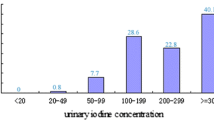Abstract
Iodine deficiency disorder (IDD) has been recognized as a major public health problem worldwide and has serious detrimental effects on the growth and development of the children. Therefore, monitoring the iodine status of the school-aged children is of great importance. We randomly recruited 159 boarding school students (aged from 6 to 14) from 10 primary schools in Lincang County, Yunnan Province. The dietary iodine level of the students was measured by the new mixed meal method and chemical analysis. Fifty-seven daily water samples and 32 salt samples were collected from the same surveyed area to determine the iodine content using the sulfate cerium catalytic spectrophotometric method and the hyposulphite quantitative titration method, respectively. The iodine level of each water sample was ranged from 0.611 to 1.473 μg/L. The median and the mean value of the iodine content in water were 0.972 and 0.979 ± 0.189 μg/L. The average iodine intake of each age group was higher that the recommended nutrient intakes (RNI) but lower than the tolerable upper intake level (UL). The median and the mean value of the iodine content in salt were 25.53 and 25.62 ± 1.70 mg/kg. Taken together, the present study investigated the iodine intake status of Wa school-aged children through examination of their dietary iodine intake, the environment, and the salt iodine status. Results showed that the status of the iodine uptake of the Wa children were higher than the RNI, but lower than the UL.

Similar content being viewed by others
References
Lee J, Kim JH, Lee SY, Lee JH (2013) Iodine status in Korean preschool children as determined by urinary iodine excretion. Eur J Nutr 53:683–688
Zimmermann MB, Jooste PL, Pandav CS (2008) Iodine-deficiency disorders. Lancet 372:1251–1262
Andersson M, Karumbunathan V, Zimmermann MB (2012) Global iodine status in 2011 and trends over the past decade. J Nutr 142:744–750
Zimmermann MB (2008) Iodine requirements and the risks and benefits of correcting iodine deficiency in populations. J Trace Elem Med Biol 22:81–92
Matthys B, Davlatmamadova M, Karimova G, Jean-Richard V, Zimmermann MB, Wyss K (2013) Iodine nutritional status and risk factors for goitre among schoolchildren in South Tajikistan. BMC Endocr Disord 13:50
Lai Y, Huang M, Li H, Wang XD, Li JL (2012) Distinct genotype distribution and haplotype profiles in MDR1 gene among Chinese Han, Bai, Wa and Tibetan ethnic groups. Pharmazie 67:938–941
Xu JW, Xu QZ, Liu H, Zeng YR (2012) Malaria treatment-seeking behaviour and related factors of Wa ethnic minority in Myanmar: a cross-sectional study. Malar J 11:417
Li W (2008) Assessment of the nutritional status of the boarding-school students in poor regions in China. Chinese Rural Econ 3:33–41
Parveen S, Latif SA, Kamal MM, Uddin MM (2007) Effects of long term iodized table salt consumption on serum T3, T4 and TSH in an iodine deficient area of Bangladesh. Mymensingh Med J 16:57–60
Brauer VF, Brauer WH, Fuhrer D, Paschke R (2005) Iodine nutrition, nodular thyroid disease, and urinary iodine excretion in a German university study population. Thyroid 15:364–370
Laurberg P, Bulow Pedersen I, Knudsen N, Ovesen L, Andersen S (2001) Environmental iodine intake affects the type of nonmalignant thyroid disease. Thyroid 11:457–469
Mallard SR, Houghton LA (2013) Public health policy to redress iodine insufficiency in pregnant women may widen sociodemographic disparities. Public Health Nutr 1–9
Zimmermann MB (2013) Nutrition: are mild maternal iodine deficiency and child IQ linked? Nat Rev Endocrinol 9:505–506
Meng F, Zhao R, Liu P, Liu L, Liu S (2013) Assessment of iodine status in children, adults, pregnant women and lactating women in iodine-replete areas of china. PLoS One 8:e81294
Vought RL, London WT, Lutwak L, Dublin TD (1963) Reliability of estimates of serum inorganic iodine and daily fecal and urinary iodine excretion from single casual specimens. J Clin Endocrinol Metab 23:1218–1228
Perrine CG, Cogswell ME, Swanson CA, Sullivan KM, Chen TC, Carriquiry A, Dodd KW, Caldwell K, Wamg CY (2013) Comparison of population iodine estimates from 24-hr urine and timed spot urine samples. Thyroid 24:748–757
Rasmussen LB, Ovesen L, Christiansen E (1999) Day-to-day and within-day variation in urinary iodine excretion. Eur J Clin Nutr 53:401–407
Six BL, Schap TE, Kerr DA, Boushey CJ (2011) Evaluation of the food and nutrient database for dietary studies for use with a mobile telephone food record. J Food Compost Anal 24:1160–1167
Pampaloni B, Bartolini E, Barbieri M, Piscitelli P, Di Tanna GL, Giolli L, Brandi ML (2013) Validation of a food-frequency questionnaire for the assessment of calcium intake in schoolchildren aged 9-10 years. Calcif Tissue Int 93:23–38
Waling MU, Larsson CL (2009) Energy intake of Swedish overweight and obese children is underestimated using a diet history interview. J Nutr 139:522–527
Acknowledgments
The research was supported by Department of Yunnan Province-Kunming Medical University of Applied Basic Research Special Fund Project (2010CD225).
Conflict of Interest
The authors declare that they have no conflict of interest.
Author information
Authors and Affiliations
Corresponding author
Additional information
Jian-Zhong Yin, Yue-Mei Feng, and Shao-Xiong Wu contributed equally to this work. The work was carried out at Kunming Medical University.
Rights and permissions
About this article
Cite this article
Yin, JZ., Feng, YM., Wu, SX. et al. Assessment of the Iodine Status of the Wa National Boarding School Students in Southwest China. Biol Trace Elem Res 160, 316–320 (2014). https://doi.org/10.1007/s12011-014-0072-y
Received:
Accepted:
Published:
Issue Date:
DOI: https://doi.org/10.1007/s12011-014-0072-y




